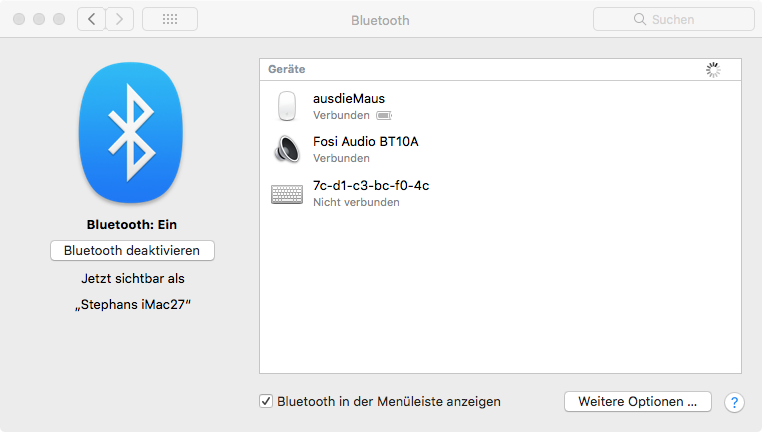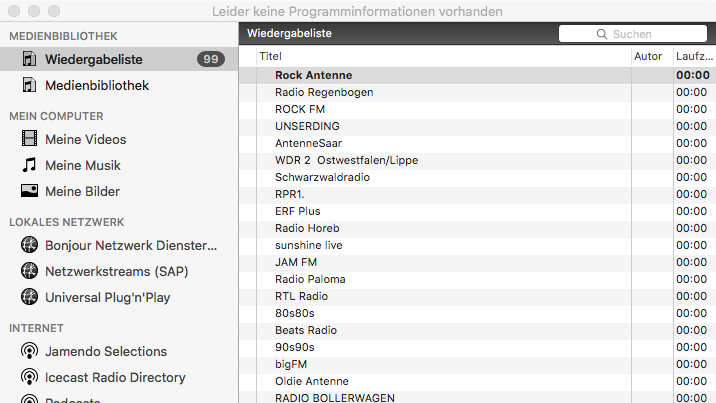After hardware and software, we now have the finishing touches – and a detailed conclusion.
Probably you got it, I failed an old case radio and almost at the same time an iMac27 from 2011 came to me. So the idea was to quickly turn the Mac into an MC, and that although I'm not even a big rap fan. It's fascinating.
In Act 1 and Act 2 This adventure has worked so well so far, now it's still about the finishing touches.
Maestro, music please!
What I hadn't considered at first was the output of my media data. Yes, of course, the screen is quite nice, but actually I want to listen to radio or podcasts, play CDs, maybe run a movie trailer or news on demand. Of course, the built-in boxes are a bit underpowered.
How good that I still had a small Fossi audio amplifier with 2 satellite boxes flying around from a basement find, the can Bluetooth, that will be really good! Think about it!
The Fossi Amp is relatively up-to-date, while the Mac is already an old one. The Fossi would have liked that someone with halfway The Modern Protocol, i.e. BT4.0LE is talking to him, but the apple colleague only likes to go up to version 2.1 ERD – so attempts to pair the two failed miserably. Och ⁇
In the end, this also cost me more time than would have been necessary here. Basically, I prefer simple solutions, so here with the 3.5 jack plug cable! It's up and running!
Plan B would be in such a case – I don’t know if only I didn’t get there earlier – some old set of PC loudspeakers, which are certainly still lying around in the basement or attic. At least once completely ok, if necessary you can really escalate with 5.1 or even more!
Plan C came to mind when I wrote: A Bluetooth USB key that delivers at least 4.0, but the analog solution should also be right for me here.
<Supplement>
Apparently I gave up impatience as Fritz last time too quickly or the intermittent trying out with an Edimax 8500 BT5.0 stick has now persuaded the system to cooperate, although I have not loaded or changed anything extra? – In any event, now everything also works with the internal Bluetooth connection to the Fossi.
</Supplement>

Well, amplifiers and boxes are on, now it's about integrating the sources. I have a plex server. LXC Container in my Homelab, He's been serving the music to the Plexamp app. Fits.
Jellyfin can otherwise provide you with all other media content. Everyone will have to roll the dice for themselves. Plex is known for its user-friendly interface and extensive features, while Jellyfin is a free, open source alternative that offers more control over your media.
Plex Mediaserver Brief overview:
- Benefits:
- User-friendly interface.
- Extensive functions, especially with Plex Pass (paid).
- Stable mobile apps.
- Good streaming quality.
- Extensive community support.
- Disadvantages:
- Some features require a paid Plex Pass subscription.
- Can be perceived as less flexible compared to jellyfin.
- May contain unwanted advertising.
Jellyfin Mediaserver Brief overview:
- Benefits:
- Completely free and open source.
- More control and customization options.
- No hidden costs or subscriptions.
- Can be considered the better option for tech enthusiasts.
- Disadvantages:
- User interface can be less intuitive than Plex.
- Less comprehensive functions than Plex.
- Development may be slower than with Plex.
- It may require more technical understanding of the setup.
TL:DR
- If you are looking for a simple, user-friendly solution with many functions and are willing to pay for a subscription, Plex + Plexamp A good choice.
- If you prefer a free, open source alternative with more control and customization options, you should choose Jellyfin.
Ultimately, the best choice is the one that best suits your individual needs and technical know-how.
Then I have the Cable FritzBox and the Fritz repeater DVB, attentive readers will remember the two, which were already a topic in the home network. There you can practically search for the transmitters available in the cable and export them as .m3u.

This, in turn, can both the VLC as well as other media players what to do and the radio is running again, now even in principle with every station worldwide. The pink ghetto blaster was FM/AM FM with classic pull-out antenna. Oldscool stop It's vintage! That means vintage!
Video killed the Radio Star
It wasn't that bad, but finding a player that really copes with all the wild formats that you throw at his head was not soo easy. I thought entrance I got VLC, the drops sucked. Joah...
Let's make it short and take a look at some other players together, okay?
IINA may be a player with whom you can befriend. Officially supported in High Sierra, chic simple design and beautifully performant.
The 5KPlayer would be for videos Also a possible alternative.
And so that no one can say I disse here classics, of course the Good old MPlayer Not missing.
So, after that too, I would say it's time to look at the bottom line.
Cost-benefit analysis
Investment vs. new purchase A full upgrade (16GB RAM + 500GB SSD + professional installation) can quickly cost between 200-400 euros. If you install what goes maximum also more ⁇
So this is more suitable for someone who takes care of and installs the components themselves. Then RAM and SSD should be in the around/or/under 100 Euro range. If you happen to have something else lying around that otherwise just dusts in anyway – even better!
In the case of self-installation, the costs are thus reduced (don't forget working time) to 100-200 euros. Compared to a new iMac (starting at $1,300), this is quite economical, especially if the computer is mainly used for office applications or/and light multimedia tasks.
Quite omitted in the consideration I have now the Mac itself, but is simply because devices in this age range (~15) are usually no longer really sought after even on the used market and accordingly maximum for small money change the owner or are even given away.
Risks and considerations
Potential problems:
- Display damage during disassembly
- Overheating due to improper installation
- Time required: 2-4 hours for experienced hobbyists
- Limited future security due to obsolete macOS version
Conclusion and recommendations
An iMac upgrade of such old devices is mainly worthwhile for users who do basic computing tasks and do not need the latest software. The SSD installation brings the greatest benefit, but requires a little technical skill and patience. A clean room is not necessary, but dust on the display or glass back is unsightly. For less tech-savvy users, it is therefore more advisable to go to the specialist or to invest in a newer device.
The RAM upgrade, on the other hand, is easy to implement and brings noticeable improvements in multitasking-intensive applications. In combination with an SSD, the old iMac will once again become a quite useful work tool for the next few years.
However, restrictions on available software, security updates and general compromises by the older hardware must be on the screen.
Finally, the warning: Such a device should no longer be used as the main system and has lost nothing in the state on the Internet.